Two years that changed cars forever: 1974 (bumpers) and ’75 (smog)
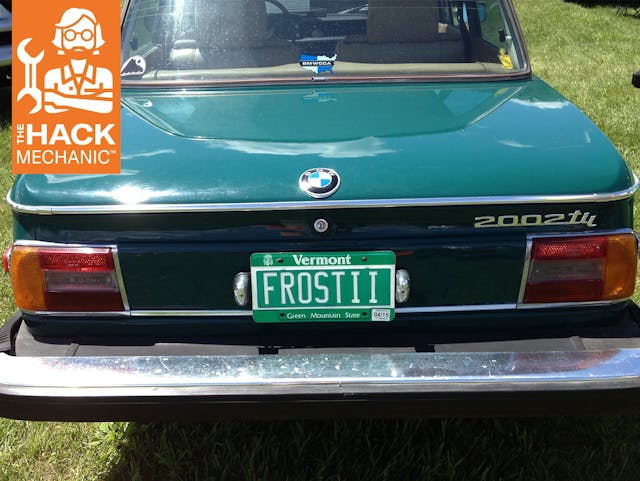
Many car nuts have a time period they’re the most attracted to. It may be 1950s cars, with their audacious tail fins and chrome, 1960s American muscle, or 1980s Italian wedges. But I’d wager there aren’t a lot of folks who, unless they’re talking in opposite-land speech, would say, “You know, cars from the mid-1970s were the absolute best, and it was nothin’ but downhill from there.”
Two years in the ’70s intertwined automotive manufacturing and government regulation like no other—1974 was the year that the United States Department of Transportation (DOT) mandated 5-mph bumpers, and 1975 was the year that the Environmental Protection Agency (EPA) dropped the hammer on smog standards. Together, these were a one-two punch that divided the automotive timeline into BBAS and ABAS (Before Bumpers and Smog and … well, you get it).
Bumpers
There were certainly automotive safety advances before the 1960s (windshield wipers, rear-view mirrors, laminated glass, four-wheel brakes), but it wasn’t until the DOT was established in 1966—and with it, the National Highway Traffic Safety Administration (NHTSA)—that the first set of Federal automotive safety standards for the United States was established. It was enacted for the 1968 model year and included many things we take for granted such as seat belts and shoulder harnesses, energy-absorbing steering columns, front disc brakes, tandem master cylinders, padded dashboards, and more.
Somewhat surprisingly, though, it did not include bumper standards; manufacturers appear to have been free to continue to use bumpers as they saw fit for a combination of non-crash-proven low-speed parking protection and stylistic enhancement. As such, up through model year 1972, the bumpers—almost always chrome-plated stamped curved metal—on most cars are very close to the body, often bolted directly to the rear clip, and only protruding in the front if standoff was necessary to protect the headlights. As such, anything but the most trivial parking tap was likely to bend the sheet metal of the car.

The first U.S. bumper regulations appear to have been part of NHTSA Federal Motor Vehicle Safety Standard No. 215 (FMVSS 215), “Exterior Protection.” They took effect in September 1972, so from a practical standpoint, they were enacted by most manufacturers for the 1973 model year. These 1973-only bumpers are often referred to as “2 ½-mph bumpers,” but that’s a bit of a misnomer. Standard 215 required that the bumpers protect safety-related systems and components such as lighting during 5-mph direct front impact tests and 2 ½-mph rear tests. On most foreign cars, the difference between 1972 and ’73 bumpers is subtle. In fact, in the vintage BMW world in which I operate, ’72 and ’73 bumpers are usually identical. What’s different is that the rear bumper, which used to attach directly to the rear clip, is spaced farther out by about two inches by a bracket; the front bracket is also about two inches longer and thicker as well; the points at which the corners of the bumpers are bolted to the fenders are moved back by that same distance; and the front has slightly different rubber “bumperettes.” So, ’72 cars may look slightly more compact, trim, and tidy than ’73s, but again, it’s subtle.


For some American cars, though, there is often a bigger stylistic difference between 1972 and ’73 bumpers than with European cars—any lighting (directionals, parking lights, license plate, or backup lights) that might have been directly incorporated into the bumper was usually moved to the body of the car for the new 1973 requirement.
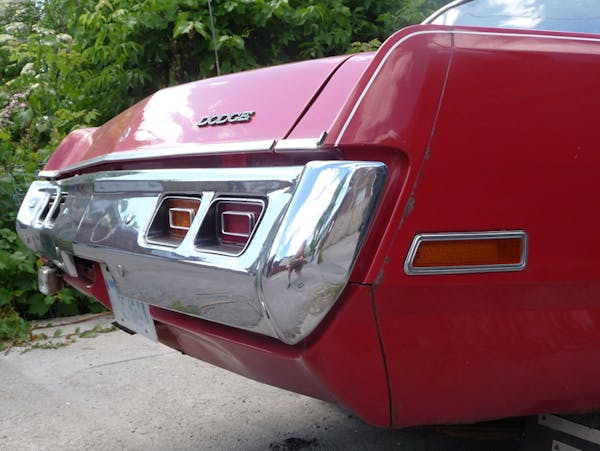
But for model year 1974, the bumper standard changed again, requiring that the car’s lighting remains intact on impacts of 5 mph both front and back, and from any angle. This was the big change that caused nearly all manufacturers to abruptly switch from the lithe and lovely curved chrome-plated bumpers that were an integral part of the vehicle’s design to something stouter. The degree of bumper integration was perhaps better with American manufacturers, as they were in the American market for the long haul. In contrast, the Europeans almost seemed to delight in hastily slapping on big aluminum bridge-abutment-like bumpers that stood nearly a foot off the body, connected by big hydraulic telescoping cylinders, and with rubber accordion-like bellows at the corners that could squeeze without bending the fenders like their old rigidly-attached chrome counterparts, as if to say, “You want 5 mph bumpers? We got your 5 mph bumpers right here, pal. We dare you to keep buying our cars.” Compare the ’73 and ’74 bumpers on a U.S.-spec Mercedes 450SL. Or a Fiat X1/9. It’s laughable.

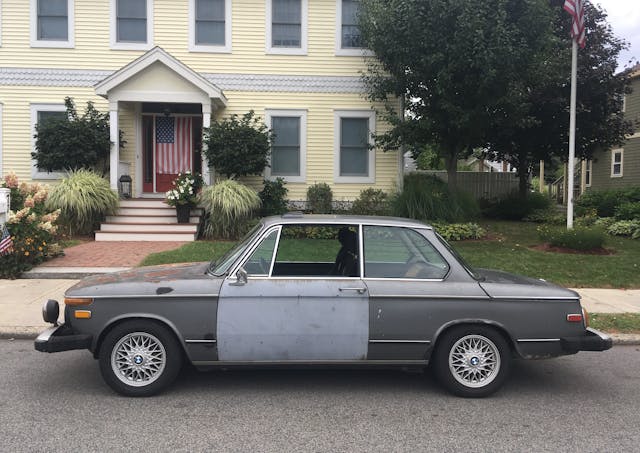
Curiously, when I bought my 1974 Lotus Europa Twin Cam Special, I noticed that it wears front and rear bumpers that are no more than ornaments, little wrist bracelets at best. I wondered if maybe the car wasn’t actually a ’74, but it turns out that the car’s low production and important numbers got Lotus an exemption.
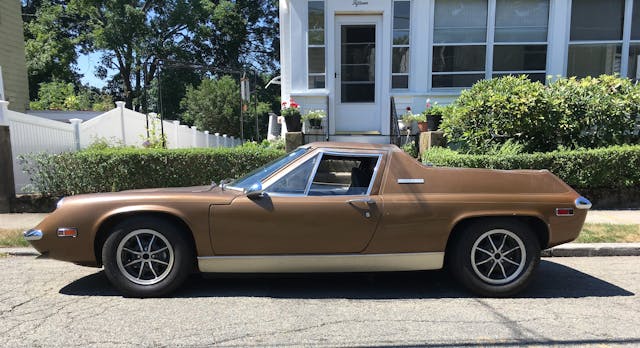
Other models were not so fortunate. Perhaps no manufacturer got it more wrong than British Leyland in its treatment of the poor MGB, which, in a design exercise reminiscent of plastic surgery gone horribly wrong, went from this:
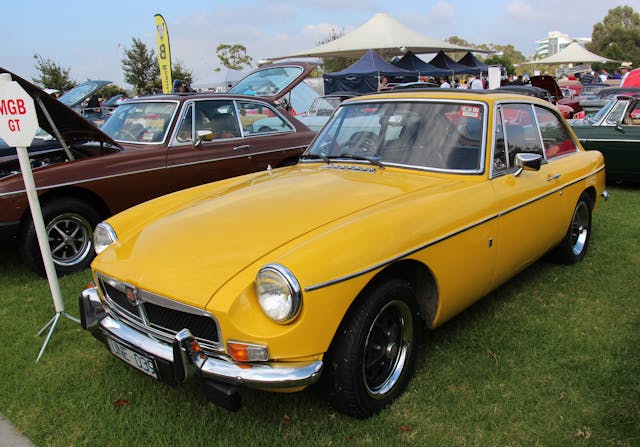
To this:
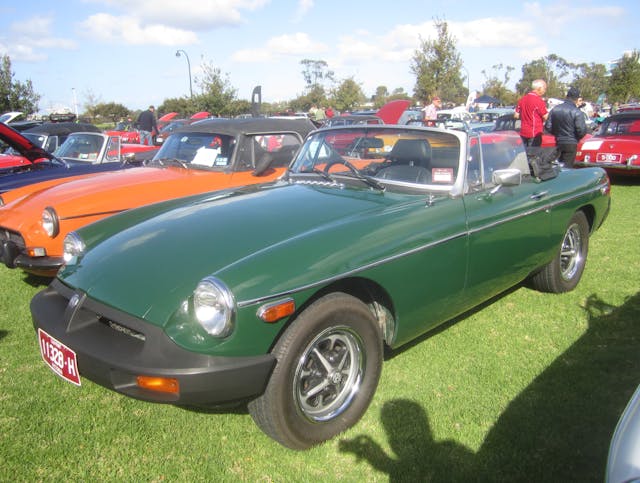
So, there you go. Now you know how to nail a car’s age from 30 feet just by looking at its bumpers. If they’re chrome and curved and right up against the body and/or have any lighting directly integrated into them, the car is likely 1972 or earlier. If they’re chrome and curved but stand slightly off the body and have no integrated lighting, the car is probably a ’73. If they’re big and ugly and look like they were slapped on by students in a junior high school shop class, the car is likely a ’74 or a few years after.
Smog
The smog story is analogous to the bumper story, but with a different U.S. regulatory agency. Our own Aaron Robinson laid it out in astonishing detail in his excellent piece in the October issue of Hagerty Drivers Club magazine, also here online, which I encourage you to read in its entirety. Basically, targets for tailpipe emission levels began being required for cars sold in California as early as 1966, ratcheting up in severity over time. While specific technical solutions to meet those requirements weren’t mandated, there are only so many ways you can cook the egg of reduction of unburnt hydrocarbons and nitrogen oxides. Positive Crankcase Ventilation (PCV) came first, followed by dashpot diaphragms on carburetors to prevent throttle plates from snapping shut too quickly and releasing blasts of raw gas out the tailpipe, Exhaust Gas Recirculation (EGR), smog pumps, lower compression, and retarded ignition.
But the big step change occurred in 1975 when the EPA really took the wrench to smog standards, slashing the tailpipe threshold in half. To be compliant, all manufacturers eventually incorporated catalytic converters, fuel injection, and an oxygen sensor, but initially, many used a competing technology: thermal reactors integrated directly into the exhaust manifold, with air injected into them to help combust and cook off any unburned hydrocarbons. For a few years, these were on everything from Pacers to Porsches to early RX7s to BMWs, and are often described as having a kiln bolted to the side of the head; at night you could see them glow red like the exhaust on a Formula One engine on a dyno. Not surprisingly, they were renowned for causing head cracking. But, hey, on the positive side, you had an indicator on your dashboard that literally said, “Reactor Service,” at least I did on my 1975 BMW 2002.
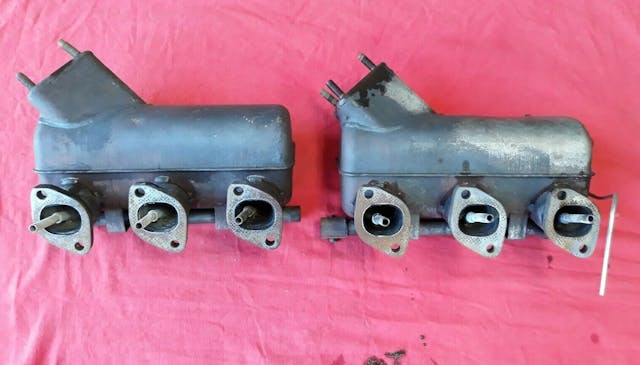
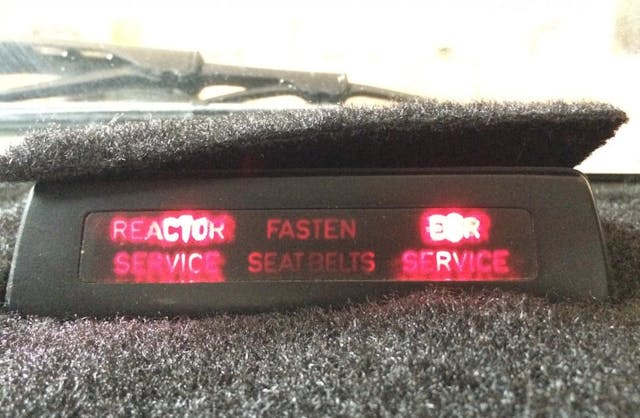
So, due to these bumpers-and-smog reasons, 1974 and ’75 set off shock waves that affected every single auto manufacturer and took several years to die down.
Some recovered more quickly than others. For example, Porsche came out with the 911SC in 1978. It had a new 3.0-liter engine whose thermal reactors had been replaced with a catalytic converter and oxygen sensor and was worlds better than the 2.7-liter 911S that preceded it. By 1979, BMW had similarly ditched the thermal reactor, and while straight-six cars like the 528i sedan and 633CSi big coupe might crack the head if you blew a coolant hose and kept driving, it would no longer do it spontaneously. But BMW took a long time to get religion regarding well-integrated bumpers. The bigger U.S.-only bumpers continued until 1988, when BMW finally adopted a smaller “world bumper” design for all of its markets.
To be absolutely clear, I’m not decrying the government regulation that produced these changes or saying that it ruined cars forever. To the contrary, cars emerged better and safer for it. It just took a few years. As per Aaron Robinson’s article, at the time, cities were so choking in smog that public health emergencies were declared. Once the teething pains were over and all new cars were designed with engines delivering precisely metered fuel via fuel injection and oxygen sensors into catalytic converter-equipped exhausts, smog levels in cities dropped. Hell, my wife can tell when I’m in the driveway idling one of the “dirty” 1970s cars versus one with a cat/O2 system in it just by the smell or lack of it inside the house.
It’s more complicated, though, trying to justify whether a thermal reactor should or shouldn’t be installed on a car it originally came on (for a window into my angst, see the Hagerty piece I wrote a few years ago (In Defense of Vintage Car Ownership). I think I’ve explained why you really need to make a lawyer’s case for buying an enthusiast car whose model-year is 1975 or shortly after, so I’m going to sidestep the whole question of whether all original emission control equipment should always be present on every car and instead simply recommend that, if you’re looking for a particular mid-1970s car, don’t buy the one that has or had a thermal reactor on it. Instead, find one that’s earlier or later. If you’re jonesing for a car like a Pacer that was only built during this period, well, it’s an unfortunate consequence of your particular taste. For a car like a BMW 2002, where the end of the timeline plunks down on 1976, it explains why the earlier cars are worth so much more money. For a car whose production straddles the dark years, like a Porsche 911, it explains perfectly why the pre-’74 cars are worth an ungodly sum, the 1975–77 cars have the lowest value of any 911, and the value zooms up again in ’78 with the 911SC.
With the bumper standards, there’s not the same backdrop of morality that there is with smog. Thirty-five years ago, I actually sold a small-bumpered BMW 2002 and intentionally bought a later big-bumpered car because I was moving back to Boston, intended to daily-drive it, and wanted those fore-and-aft battering rams for traffic and parking. I sold that car in 1988 to a friend, bought it back a few years ago, and with its usage profile no longer that of a daily driver, I decided to backdate its bumpers to the earlier smaller style. They do look much better.
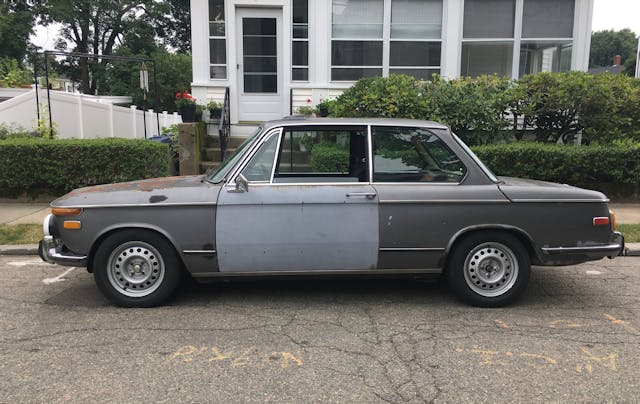
So. What era cars do I like? You now completely understand it when I say “just before bumpers got big in ’74, and just after emission control stabilized in the late ‘70s, but before everything moved over to digital engine management (computer-controlled spark advance) in the early 80s.”
Anyone wanna buy a thermal reactor?
***
Rob Siegel has been writing a column (The Hack Mechanic™) for BMW CCA Roundel magazine for 34 years and is the author of seven automotive books. His new book, The Lotus Chronicles: One man’s sordid tale of passion and madness resurrecting a 40-year-dead Lotus Europa Twin Cam Special, is now available on Amazon (as are his other books), or you can order personally-inscribed copies from Rob’s website, robsiegel.com.


as the delighted owner of a 75 S3, i was looking online to find info as to whether a Cali Quadrajet is different than a rest of the 48s.
i noticed that the doner car i found in Cali had an air pump and these nicely fashioned tubes running along the exhaust manifolds, but the carb wasso obvuously freshly rebuilt i had to get it.
Of the 75s ive had or have none have thos set up, none from Cali though.
anyway
What the designers did with an S3, to me, is so well thought out, form and function .. i prefer a colonade to a 72 or older; so many significant advancements.
I intend to tuck my rear bumper in a bit, but not flush, it makes great sence to have a lil room, why have sculpted metal compromised over a bumper tap.
i have a 69 and a 73 Ford and both have a lil damage on thr back corners from a bumper tap.
in the big picture, cars are bad for the environment, and made from more plastic and more imports everyday.
Most dont care and maintain anymore, just use and dispose.
i like the idea of slowing auto manufacturing and keeping cars longer, maybe not as far as Cuba had it, but too many cars in junk yard, to many minor issues do to negligence or lack of honest afffordable service, people just ditch em.
i went to a euro repair shop out here in So Cal on the 101, for an e39t, my first visit, and to establish repore i asked for front end inspect, codes read and an oil change.
After the cocky tech and the owner onlooking was told the shop rate is
drum roll . .
$200 per hour !?!
and that they want the car for the day.
i left, and will check my own, change my own and understand more than ever why people choose new disposable cars.
This coming generation is more interested in poke man and social media than cars, and one day not to far from today, itll be a field of kia, hyundai, toyota with US flag stickers on em.
we here, those likely to read this, lived in a very transitional time. More than safty and smog, but analogue to digital, crafted metal to plastic, human to .. .
sigh
As the delighted owner of a 75 S3, i was looking online to find info as to whether a Cali Quadrajet is different than a rest of the 48s. i noticed that the doner car i found in Cali had an air pump and nicely fashioned tubes running along the exhaust manifolds, but the carb was obviously freshly rebuilt so i had to get it. Of the 75s ive had or have, none have that set up, none are from Cali though. What the designers did with an S3, in my opinion, is so well thought out, form and function. i prefer a colonade to a 72 or older; so many significant advancements. I do intend to tuck my rear bumper in a bit, but not flush, it makes great sence to have a lil room. Why risk compromising vintage sculpted metal over a bumper tap. i have a 69 and a 73 Ford and both have a lil damage on their back corners from a bumper tap. in the big picture, cars are bad for the environment, and made from more and more plastic and more imports everyday. Most people dont care and maintain anymore, just use and dispose. i like the idea of slowing auto manufacturing and keeping cars longer, maybe not as far as Cuba had it, but too many cars in junk yard, too many minor issues due to negligence or lack of honest affordable service; people just ditch em. i went to a euro repair shop out here in So Cal on the 101, for an e39t, my first visit, and to establish repore i asked for a front end inspection, codes read and an oil change. After the cocky tech and the onlooking owner, told me the shop rate is.. drum roll . . $200 per hour !?! and that they want the car for the day, i left. j i will check my own, scan my own, change my own and understand more than ever why people choose new disposable cars. This coming generation is more interested in poke man and social media gossip than cars. One day not to far from today, itll be a maze of kia, hyundai, toyota with US flag stickers on em. We here, those likely to read this, lived in a very transitional time. More than safty and smog, but analogue to digital, crafted metal to plastic, human to .. . sigh